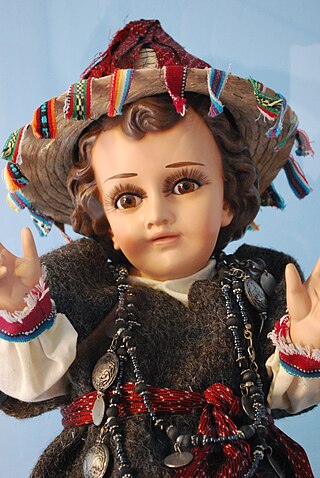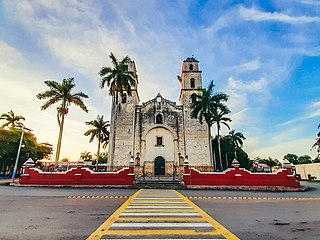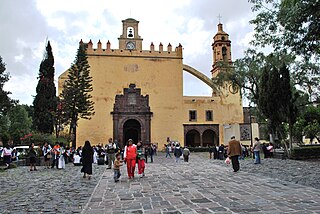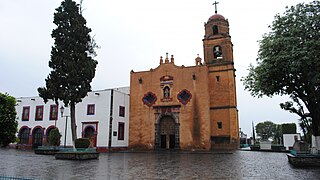This article needs additional citations for verification .(September 2015) |
San Gregorio Atlapulco is a neighbourhood located in the borough of Xochimilco in Mexico City, Mexico.
This article needs additional citations for verification .(September 2015) |
San Gregorio Atlapulco is a neighbourhood located in the borough of Xochimilco in Mexico City, Mexico.


The translation of the word "ATLAPULCO" is, "where the water churns" or on "the land of mud".
The origin of its first settlers was Xochimilca. In the superior pre-classic period, as a result of the teotihuacanos groups and the chichimecas immigrants melting pot, in the 10th century the Xochimilcas settled on the South of the Anáhuac Lake.
San Gregorio Atlapulco is a very important place due to its vegetable and medicinal plant production. This is result of its geographical location and the ancient knowledge on the use of the chinampas. Because of all this, it was taken by the Mexicas and its incorporation to the Great Tenochtitlán was in 1430 so they could get their products and use their work. The culture was so important that it had its own TLACUILOS (people devoted to register and keep all that happened in the region). Remains of this is the archeological zone at Xilotepec Hill that is at the top, under the crosses, from which you may see the whole town. Today they are called “La malinche”y “Juan Tamborilero”. They are in very bad condition because they have suffered from both erosion and vandalism. But before that, they were almost destructed during the Colonial period because of the imposed religion and with it the intention that the Xochimilcas forgot their gods.
Founded over 400 years ago, it was originally a community of the Acolhua peoples, who named their region, “Atlatl,” which has several possible translations, including “Where the springs were destroyed,” “Where water is lost,” “muddy waters,” or “Where the water flows.” (Xochimilco webpage). As skilled agriculturists, the Acolhuas were a peaceful society that had important spiritual practices around their horticulture. https://web.archive.org/web/20150415022817/http://www.xochimilco.df.gob.mx/pueblos-y-barrios.html
Today, San Gregorio Atlapulco is divided in 8 quarters: Caltonco, Salí, Olipatitla, La Ermita, Tlatilpa, Axayopa, Las Animas, Minas, San Andrés and San Juan (Moyotepec). https://web.archive.org/web/20150415022817/http://www.xochimilco.df.gob.mx/pueblos-y-barrios.html
San Gregorio is one of the largest communities in the District of Xochimilco. In the census of 1900 there were 15,672 residents documented. In 1950 the population in San Gregorio was 21,405; in 1970, 24,700 and 1981, the population rose to over twenty eight thousand. https://web.archive.org/web/20150415022817/http://www.xochimilco.df.gob.mx/pueblos-y-barrios.html
The main sites of the neighbourhood are the Plaza cívica de San Gregorio Atlapulco, the church, the Convento de San Gregorio Magno, and the market.
The Plaza cívica de San Gregorio Atlapulco is located at the corner of Avenida México Ote and Avenida Cuauhtémoc. The plaza is a backdrop for several important statues and a mural. The statues include the statue of Emiliano Zapata and Cuahtémoc. In addition, there is a mural titled, “Paisajes de nuestro Pueblo” that was commissioned by the Comité de Feria in 2002. The plaza is used as a central meeting place for festivals and important events. As well, the plaza hosts dance recitals and workshops by the renowned dance company, “Tlayolohtli.” https://www.facebook.com/companiadedanzatlayolohtli/info?tab=page_info
Next to the plaza and church, there is a street with a market where local residents sell everything from vegetables to arts and crafts.
La Iglesia de San Gregorio Magno is an important place of worship for the community of San Gregorio, connecting the residents to catholic traditions. The church marks the arrival of the Spanish in the 16th century. https://librovocesdesangregorioatlapulco.files.wordpress.com/2014/11/libro-a-san-gregorio.pdf

The ATLAPULCO Glyph is registered in the Mendocino or Mendoza Codice which was sent to Charles V by Antonio de Mendoza, New Spain Viceroy from 1535 to 1550, with the intention to inform about Mexicans.

The founding of San Gregorio Atlapulco town was a little after the Spanish invasion and conquest in 1555. Its patron saint's day is the 12th of March, day in which San Gregorio Magno, who was a doctor, a catholic church pope and now a saint, died.
The fact that the celebration is the 12th of March has been linked to some rituals and pre-Hispanic feasts honoring Chicomecoatl (náhuatl: chicomecoatl, ‘seven snake ’‘chicome, seven; coatl, snake’). She was the survival Mexica goddess of the maize, in special, vegetation's main patron and, extensively, fertility goddess. This, according to some studious of the local history, like Roberto Páez and Jaime Tirso Perez Venancio. In this day, there are Aztec and "conchero" dances. In an interview to one of the "concheros", he was asked to whom he addressed his worship, and he answered that it was for the Saint as well as for Tlaloc.
The 2nd of February celebration, generally called Candelaria Day, was usually celebrated the 14th of the same month, and it was called Epiphany (which means Virgin Mary's Purification).
Now in San Gregorio town the feast begins a day before with The Candelaria Virgin vigil. The church is decorated with paper trimmings and purple color flowers. The Virgin is never in the church, except the 1st and 2 February. She is always in a house in the town. Any family can ask for Her, and She is given for a year to them, as well as the church's Child.
The concheros are the ones in charge to take the Virgin from the house of the family to the church. They are accompanied by the people who go dancing and praying all the way. (This is repeated when She is taken to another family on the 2nd of February). With respect to the Child, they are taken the dawn of that day dressed in an outfit decided by their families. They are welcomed with the "mañanitas" sung and played by "mariachis". They play waltzes later and dancers, "concheros" and the godparents participate with chants and prays. When the vigil finishes, the Child is taken by their families and the Virgin is left there alone.
On this 2 February, early in the morning activities begin. The women go the mill to grind their hot peppers and species to prepare the "mole" and the tamale dough. Some people kill their turkeys or their hens to be consumed in the celebration. All the activities must be finished before noon because at 12:00 the Virgin and Child mass begins.
Just a little before 12:00 people with their Child start arriving (a godparent may have more than one Child). The Child is dressed according to the godparent's preference; nevertheless, according to the tradition, if it is the first time that the Child is going to be blessed, He is dressed in the Child of the doves outfit, which represents the coming of the Holly Spirit. In the years to come the outfit is different. In the meantime, before the mass begins, the "mariachis" play waltzes celebrating the Honorees.
Additionally to taking their Child to the mass, people also take their seeds of corn, beans, wheat, squash, pumpkin, among others, to ask for a good harvest and to never lack them; they also take candles, images and eggs.
The second great celebration is the one of the neighborhood´s San Andres Saint, which is celebrated on the 30th of November. It is believed that it is to honor the Saint, but the true is that it is to commemorate the founding of the place. The people in the neighborhood begin preparing and collecting contributions 2 or 3 months before to have what is necessary for the celebration. When the day comes, early in the morning, the families prepare the meal; later on they go to the "jaripeo" or horse show, there are fireworks and at night people dance in both chapels, in San Andres el Bajo the dance is for youngsters and in San Andres el Alto it is for adults; it is mentioned that this is the occasion for a collective drunkenness.
Another big feast is in honor of the Saint Patron of the town San Gregorio el Magno, which is celebrated the 12th of March. This is an excessively lavish celebration. In this one the two blocks in the town antagonize to show who prepares the best party. The first day is for the first block and the second for the second one. This is a very important day for the "Atlamulquences", due to the fact that this day they up-date their identity, shaking hands with the old neighbors. Nine days after, the celebration finishes with a mass honoring the name of the Saint Patron. An important word for the town, because it is also part of its people identity, is "chicuarote" that has two meanings,1) hot pepper, and 2) stubborn or nasty.
At 12:00 the mass honoring the Virgin begins and, after it, a mass honoring the Child is celebrated (in the churchyard and in a shrine the Child is placed). The Child´s new Christian steward in each neighborhood gets Him with flowers, balloons and music from the old Christian steward´s house. He is taken to the church going inside by the main entrance with their banners and the name of the corresponding neighborhood on them. (This happens outside the church while the Virgin´s mass is taking place).

Cholula, is a city and district located in the metropolitan area of Puebla, Mexico. Cholula is best known for its Great Pyramid, with the Iglesia de Nuestra Señora de los Remedios sanctuary on top, as well as its numerous churches.

Xochimilco is a borough of Mexico City. The borough is centered on the formerly independent city of Xochimilco, which was established on what was the southern shore of Lake Xochimilco in the precolonial period.

Tláhuac is a borough in the Mexico City, located in the southeastern edge of the entity. Though Tláhuac still contains rural communities within its borders, mostly in the southern and eastern portions, the borough has undergone a massive shift from urbanization, especially in its northwest. Tláhuac has experienced the fastest rate of population growth in Mexico City since the 1960s.
A patronal feast or patronal festival is a yearly celebration dedicated – in countries influenced by Christianity – to the 'heavenly advocate' or 'patron' of the location holding the festival, who is a saint or virgin. The day of this celebration is called patronal feast day, patronal day or patron day of said location.

Angono, officially the Municipality of Angono, is a 1st class urban municipality in the province of Rizal, Philippines. According to the 2020 census, it has a population of 130,494 people.

Nochistlán is a city in the Mexican state of Zacatecas. Nuño Beltrán de Guzmán, on December 3, 1531, hired Cristóbal de Oñate to establish a village in Nochistlán; the village would be named Guadalajara to honor Guzmán for having been born in Guadalajara. Guadalajara was founded in Nochistlán on January 5, 1532. Its first officials were Cristóbal de Oñate, Sancho Ortiz de Zúñiga, Juan de Albornoz and Miguel de Ibarra. They worked at this project for only 16 months and created the first layout of Guadalajara.

Candlemas, also known as the Feast of the Presentation of Jesus Christ, the Feast of the Purification of the Blessed Virgin Mary, or the Feast of the Holy Encounter, is a Christian holiday commemorating the presentation of Jesus at the Temple. It is based upon the account of the presentation of Jesus in Luke 2:22–40. Under Leviticus 12, a woman was to be purified by presenting a lamb as a burnt offering, and either a young pigeon or dove as sin offering, 33 days after a boy's circumcision. It falls on 2 February, which is traditionally the 40th day of and the conclusion of the Christmas–Epiphany season. While it is customary for Christians in some countries to remove their Christmas decorations on Twelfth Night, those in other Christian countries historically remove them after Candlemas. On Candlemas, many Christians also take their candles to their local church, where they are blessed and then used for the rest of the year; for Christians, these blessed candles serve as a symbol of Jesus Christ, who is the Light of the World.

Isidore the Labourer, also known as Isidore the Farmer, was a Spanish farmworker known for his piety toward the poor and animals. He is the Catholic patron saint of farmers, and of Madrid; El Gobernador, Jalisco; La Ceiba, Honduras; and of Tocoa, Honduras. His feast day is celebrated on 15 May.

Cártama is a town and municipality in the province of Málaga, part of the autonomous community of Andalusia, southern Spain. The municipality is situated approximately 17 km (11 mi) from Málaga. It is one of the most extensive towns in the province, covering c. 150 km2 (58 sq mi). Cártama has a population of approximately 15,000 residents.
Cordobilla de Lácara is a municipality located in the province of Badajoz, Extremadura, Spain. According to the 2005 census (INE), the municipality has a population of 1023 inhabitants.

The Niño Dios of Mexico is a tradition of venerating the Child Jesus in Mexico which has taken root from the time it was introduced in the 16th century and then synchronized with pre-Hispanic elements to form some unique traditions. Mexican Catholics have their own images of the Child Jesus, which is honored and celebrated during the Christmas season, especially on Christmas Eve and on Candlemas. One tradition unique to Mexico is to dress the image in new clothing each year for presentation at Mass on Candlemas. This dress can vary from representations of the saints, Aztec dress, football/soccer players and more. Also, there are Niño Dios images which are locally famous and honored year-round.

Our Lady of Peñafrancia is an image of the Blessed Virgin Mary in the Philippines. The Marian image is permanently enshrined in the Minor Basilica of Our Lady of Peñafrancia in Naga, Camarines Sur.

Espita is a town in Espita Municipality, Yucatán (Mexico) located on the Litoral Oriente or Region I of Yucatan. It has an average height of 27 meters and is located at a distance of 165 km from the Merida City, 80 km from Izamal, 58 km from Chichen Itza, 49 km from Valladolid, 35 km from Ekʼ Balam and 27 km from Tizimín.

Cuahilama is a Hill and an archaeological site located south east of Santa Cruz Acalpixca, in the Cuahilama neighborhood, near the Xochimilco Archaeological Museum, in Mexico City. It was a ceremonial center, in the hill are prehispanic images engraved in basaltic rock.

The Niñopa or Niñopan is the most venerated image of the Child Jesus in the Mexico City borough of Xochimilco. It was created over 430 years ago in the San Bernardino monastery, as part of evangelization efforts. Since then it has been in the possession of the community. Rather than being kept in the parish church it is in the custody of a sponsor or mayordomo, whose family is in charge of the many festivities and traditions associated with the image for a year. These include taking care of the image proper along with taking the image to church and to visit the sick. It also includes sponsoring many parties especially on certain dates such as Candlemas and Day of the Child on April 30.

San Bernardino de Siena Church is the parish church of the borough of Xochimilco in Mexico City. The church and former monastery complex was built in the 16th century over a former pre-Hispanic temple as part of evangelization efforts after the Spanish conquest of the Aztec Empire. Since its construction, it has been the center of much of Xochimilco’s history and social life, including ceremonies related to is famous image of the Child Jesus called the Niñopa. The interior of the church contains a rare 16th-century altarpiece in Plateresque style with no columns or other supports. The only other altarpiece like it is in Huejotzingo, Puebla.

The Concheros dance, also known as the dance of the Chichimecas, Aztecas and Mexicas, is an important traditional dance and ceremony which has been performed in Mexico since early in the colonial period. It presents syncretic features both pre-Hispanic and Christian. The dance has strong visual markers of its pre-Hispanic roots with feathered regalia, indigenous dance steps and indigenous instruments such as drums. However, the name Concheros comes from a type of lute made with an armadillo shell, showing Spanish influence. The dance in its current form was the adaptation of the old "mitote" dance to Catholicism as a means of preserving some aspects of indigenous rite. It remained a purely religious ceremony until the mid 20th century when political and social changes in Mexico also gave it cultural significance as a folk dance. Since the later 20th century, a sub group of the dance called Mexicas has emerged with the aim of eliminating the European influence, often with political aims. This form of the dance migrated to the United States in the mid-1970s and can be seen in states such as California in Mexican American communities.

Christmas in Mexico is observed from December 12 to January 6, with one additional celebration on February 2. Traditional decorations displayed on this holiday include nativity scenes, poinsettias, and Christmas trees. The season begins with celebrations related to the Virgin of Guadalupe, the Patroness of Mexico, followed by traditions such as Las Posadas and Pastorelas.

The San Sebastian Parish Church, informally known as Lumban Church, is the only Roman Catholic church in Lumban, Laguna, Philippines. Its titular is St. Sebastian and its feast is celebrated every January 20. The first tabernacle outside Manila was inaugurated in Lumban including the first Eucharistic Procession outside of Manila. The Franciscans established the first School for Church Music in the country in this town under Juan de Santa Maria. Today, the church is under the pastoral care of the Clerical Congregation of the Missionaries of Faith.

Santa María Tepepan is one of the 14 recognized original pueblos that form the México City´s borough of Xochimilco. It sits on the lower edges of the mountain chain that limits Mexico City to the south. Although it is in Mexico City's territory, it conserves a lot of rural characteristics, like winding cobblestone streets, and economic activities, equestrianism being one of the most important ones until recently.